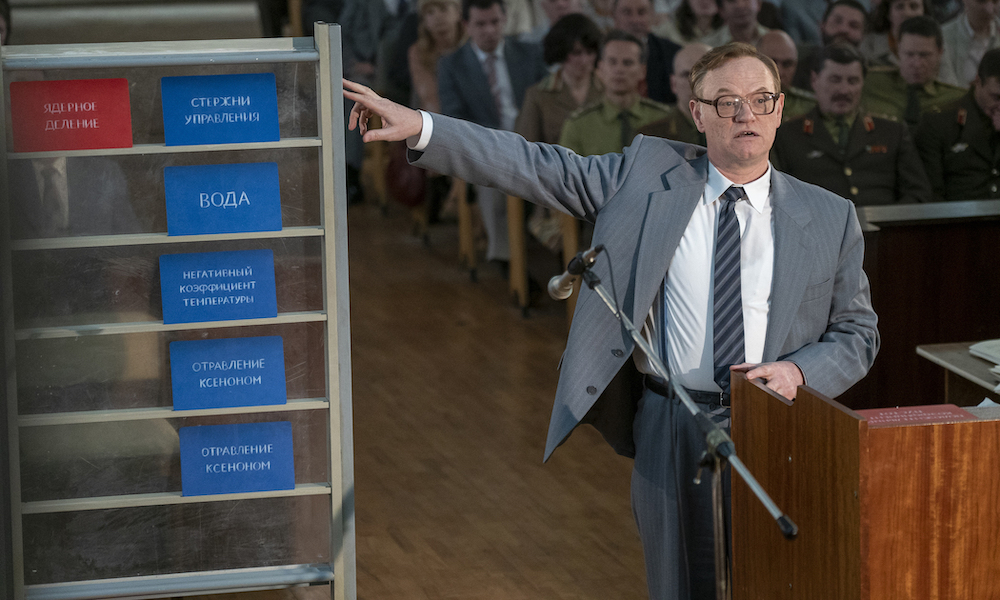Welcome to Chai Brow, Moment’s weekly arts column exploring contemporary film, TV and podcasts from a Jewish lens.
Every time the Emmys come around, I realize just how little television I actually keep up with. It’s not because I turn up my nose at TV; it’s because I’m a terrible binge-watcher. More than one episode of anything in one sitting and I start to get fidgety, thinking about the 10 (or more) hours of ground I’d still have to cover if I ever wanted to truly join the conversation. Then I’m overcome with a strong urge to answer emails or fold laundry instead. A whole season? Fuhgeddaboudit.
But this year, with the Emmys airing on Sunday, there’s one show I absolutely must implore you to watch. It’s only five episodes long. It’s nominated in seven categories. And it’s one of the most astounding feats of visual storytelling I’ve ever seen. Even I, The Anxious One, finished the whole go in one weekend.
That show, my friends, is Chernobyl.
HBO’s historical miniseries about the largest nuclear disaster in human history, created by Jewish writer-producer Craig Mazin, is absolutely gripping: a sweeping epic account of an avoidable tragedy, as well as a thorough indictment of the depths to which individuals and governments will stoop in the name of self-preservation. It avoids becoming an anti-nuclear or anti-Soviet polemic, either of which would have been the easy way to pat viewers on the back. Nor does it make the whole thing a Bataan Death March of human misery, too sad for people to watch.
What I find so remarkable about Chernobyl is twofold. First, there is Mazin’s sprawling, non-traditional narrative, which illustrates the progression of the blast and its fallout by showing how different instruments of the state dealt with it. This often means we get caught up watching scenes where, appropriate enough for the setting, the workers are mere nameless instruments of their surroundings. There are the miners who must dig a tunnel underneath the reactor (and wind up doing so naked), and the men (euphemistically referred to as “bio-robots”) who only have 90 seconds each to run onto the plant’s roof and scoop out shovelfuls of radioactive graphite. The approach makes economic sense, since it lets us cover more ground, but it’s also a brilliant narrative gambit. We’re forced to see the problem the same way the Soviets did: as a group effort.
The second thing I love about this show is the way it uses precise visual language to communicate the mortal dangers and catastrophic errors in judgment that make up the heart of such a sorry chapter in civilization. The first episode alone features too many gut punches to count: a nuclear technician pressured to shuffle onto the roof of the ruined facility and stare point-blank into an open reactor; a bird dropping dead onto the sidewalk as happy children flock to school around it; and, of course, the explosion itself, only glimpsed from far away as its effects quickly spread.
Such masterstrokes continue through the other episodes, while also finally giving us some characters. Jared Harris, Emily Watson and Stellan Skarsgård put in excellent work as two scientists and a party official who become the only voices of sanity. There are moments in the show’s later stretches where it suffers from attempts to decode Communist logic for Westerners in vague and dissatisfying ways. But it all comes to a glorious head in the ending, when finally truth must be spoken to power because all other avenues have been exhausted.
The real Chernobyl, as we are reminded in the final episode, used to be a heavily Jewish region prior to the pogroms of the early 20th century: This is a landscape with a history of violently driving out its population. Chernobyl’s commitment to central themes like this is rare for episodic entertainment, which has a regrettable habit of meandering from one plotline to the next in order to fill space. If more shows were like this, I think we’d learn a thing or two—not just about the world, but also about the kind of art we should consider truly binge-worthy.


